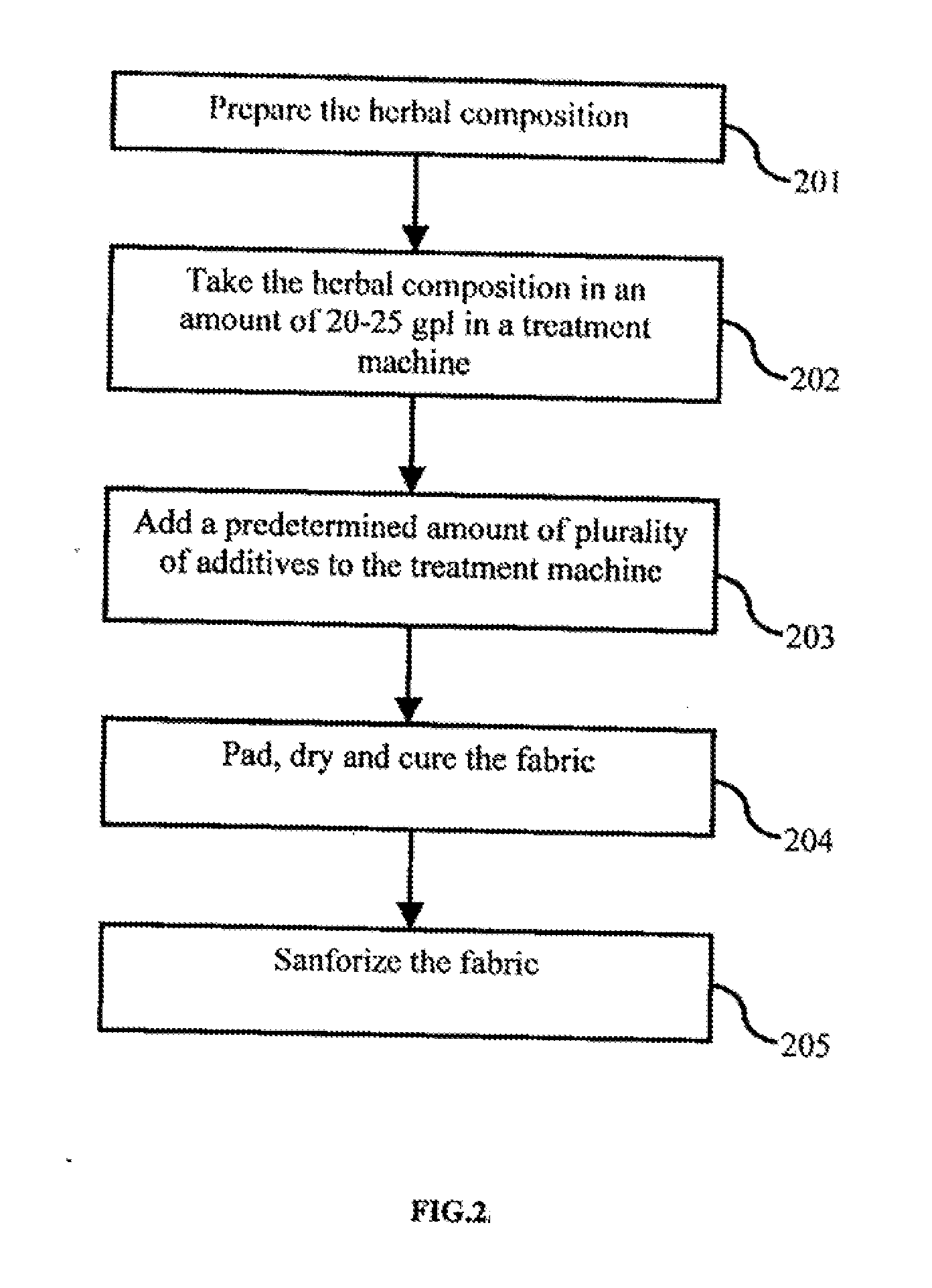Textile products with herbal composition to render the fabrics insects repellent
- Summary
- Abstract
- Description
- Claims
- Application Information
AI Technical Summary
Benefits of technology
Problems solved by technology
Method used
Image
Examples
example 2
[0110]The Oil is expelled from the Neem Seeds and filtered. Saponification of the filtered Neem Seed Oil is done. To 25 Kgs of filtered Neem Oil, about 60 Litres of water is added and stirred with high speed at room temperature. During stirring only 7 Kgs of Caustic Soda / Potash Liquid (1:1) is added slowly and speedily stirred till 30 minutes and kept overnight afterwards. Next morning, it is added with 15 Kgs of Glauber's Salt (Na2SO4) and stirred and kept for about 4 hours. Once separation occurs, the Saponified Neem Oil Extract floats above the water. It is separated by removing the excess water and is stirred again by adding with 50 Litres of fresh water. Then, around 1 Kg of 70% Sulpuric Acid (H2SO4) is slowly added to it in order to neutralize the free alkali and to bring the pH around 7. Then, 4. 1 Kg of Emulsifier (Alcohol Ethoxylate) is now added to this formulation for achieving further good emulsification. At least 10 Kgs of Glauber's Salt (Na2...
example 3
Bleached Finishing (White)
[0111]The bleached fabrics are subjected to the treatment process. The herbal composition is prepared by mixing all the herbal ingredients in their effective amounts. The herbal ingredients comprise azadiradione, fraxinellone, nimbin, salannin, salannol, vepinin and vilasinin. Table 9 shows the composition of the herbal composition according to the present invention.
TABLE 9Composition of the herbal compositionAmount inparts per millionIngredients(ppm)azadiradione30 to 250ppmfraxinellone15 to 125ppmnimbin450 to 2400ppmsalannin110 to 2050ppmsalannol168 to 3800ppmvepinin15 to 125ppmvilasinin15 to 125ppm
[0112]Other additives such as the pigment binder, anti-thermo migrating agent, amino silicon emulsion, Glauber's salt and the acetic acid are added in their effective amount as mentioned in table 10.
TABLE 10Composition with their effective amounts used hereinIngredientsEffective AmountHerbal composition of present20-25gplinventionPigment Binder12-15gplAnti-Therm...
example 4
Bleached Finishing on Stenter
[0114]The present invention is used on the bleached fabrics on Stenter machine also. A Stenter machine is used for evenly stretching or stentering the fabrics. The bleached fabric of any count and construction is taken along with the blend composition. The fabric is padded on the Stenter using the solution having the composition shown in Table 11.
TABLE 11Composition with their effective amounts used hereinIngredientsEffective AmountHerbal composition of present22-25gplinventionPigment Binder12-15gplAnti-Thermo Migrating Agent2-5gplAmino Silicon Emulsion5gplGlauber's Salt5gplAcetic Acid0.5gpl(to maintain pH of 5.5 to 6.5)
[0115]The herbal composition has a composition as mentioned in table 9 above. The fabric is then dried on the Stenter maintaining a temperature from 110° C. in the first compartment followed by 160° C. in the next two compartments of the Stenter. The speed of the fabric in the Stenter is maintained at 20-25 Mtrs of fabric per minute. The ...
PUM
| Property | Measurement | Unit |
|---|---|---|
| Temperature | aaaaa | aaaaa |
| Temperature | aaaaa | aaaaa |
| Temperature | aaaaa | aaaaa |
Abstract
Description
Claims
Application Information
 Login to View More
Login to View More - R&D
- Intellectual Property
- Life Sciences
- Materials
- Tech Scout
- Unparalleled Data Quality
- Higher Quality Content
- 60% Fewer Hallucinations
Browse by: Latest US Patents, China's latest patents, Technical Efficacy Thesaurus, Application Domain, Technology Topic, Popular Technical Reports.
© 2025 PatSnap. All rights reserved.Legal|Privacy policy|Modern Slavery Act Transparency Statement|Sitemap|About US| Contact US: help@patsnap.com



